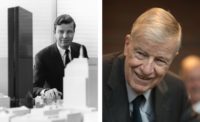 |
| Henry Urbach |
| Photo © Winni Wintermeyer |
Henry Urbach, a one-time gallery owner who most recently was curator of architecture and design at the San Francisco Museum of Modern Art, will be moving to New Canaan, Connecticut. He has just been named director of the Glass House, the Philip Johnson estate now owned by the National Trust for Historic Preservation. (He succeeds the interim director, Rena Zurofsky, and founding director, Chisty MacLear.)
Fred Bernstein: Did you visit the Glass House while Philip was alive?
Henry Urbach: In 2001, when I was running the gallery in New York [Henry Urbach Architecture], I was invited on a Saturday morning. It felt like I was being summoned, which I was. I brought a portfolio of work from the gallery, to present to Philip. He was extremely interested in the work, especially that of LOT-EK and some of the younger architects. And then we walked down to the lake pavilion. I had of course known it from photographs. But nothing had prepared me for the impact.
FB: And did you return?
HU: Last year, I began research on the Glass House as a curatorial project. Johnson, of course, was the founding architecture curator at the Museum of Modern Art. But the Glass House, too, can be understood as a curatorial space, where art, architecture, landscape and people were brought together, recombined and displayed in ways that were influential. So I made a visit to explore that aspect of it, and one of the staff members, who was kind enough to take me around, mentioned that there was a director’s search.
FB: With the new job, will you have time to complete your book Installation Architecture: A Primer?
HU: Most of the research is done. There are about 40 featured architects, starting around 1970, with Coop Himmelblau, Ant Farm, Florian St. Florian, and moving on to Diller Scofidio + Renfro, Lebbeus Woods, Juergen Mayer H., Alex Schweder, and others.
But it’s not just history. There’s an argument to the book, too, about understanding installation architecture as a way of producing an actual spatial experience at full scale. It’s a response to the problem of showing architecture in a museum or gallery.
FB: Do you think you may bring installation architecture to the Glass House grounds?
HU: Once I get settled in, we will begin a looking at the best ways to bring forward new work on the site—with an eye to what Philip and David [Whitney] did, including commissioning site-specific sculpture.
FB: Will you live in the Glass House?
No, the Glass House will remain a precious historical artifact. But I will be living on the property, in the house known as Colluna Farms. I can't tell you how exciting it will be to occupy one of modern architecture's hallowed grounds.


Post a comment to this article
Report Abusive Comment